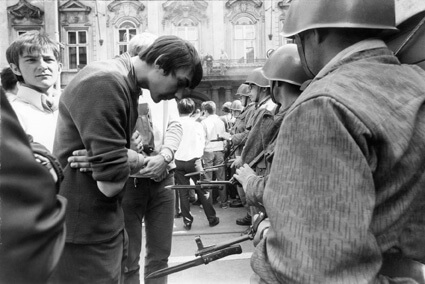
© Fondation Gilles Caron
Exhibition
Gilles Caron. The Conflict Within
From 21 June to 02 November 2014
Jeu de Paume – Tours
In the space of just a few years Gilles Caron, a passionate and audacious young journalist, made his mark in the world of photography breathing new life into a genre: photojournalism. He founded the photographic agency Gamma in 1968 with Raymond Depardon and rapidly made a name for himself by covering all of the period’s major conflicts: the Middle East, Vietnam, Chad, Northern Ireland, Biafra… Wherever there was fighting, he was there with his camera until one day in April 1970, 5 April to be precise, when he disappeared in Cambodia in a zone controlled by the Khmer Rouge.
Although he was primarily known as a war reporter, Caron’s photography is also remarkable for the way he managed to capture the quintessential spirit of the 1960s: cinema and France’s Nouvelle Vague, fashion, music, the rebellious younger generation and politics are amongst his main subjects, those that inspired some of his most striking images. His extremely realistic account of the events of May 1968, in particular his famous photo of Daniel Cohn-Bendit confronting a CRS riot policeman, are indelibly fixed in our collective memory. In just a few short years, Caron managed to prove that he was one of photojournalism’s greats. The one hundred and fifty photos on show in this exhibition, “Gilles Caron. The Conflict Within“, present the work of a man who never ceased to question the purpose of his commitment.
The photos of Gilles Caron (1939–1970) tell the story of his times through his visual account of the period’s major conflicts: the Six Day War, Vietnam, Biafra, Northern Ireland, May 68, the repression of the Prague Spring… He finished by paying for this commitment with his life, whilst covering the war in Cambodia.
He was called up during the Algerian war and joined the parachute regiment, where he was a witness to the brutalities inflicted upon the civilian population. By throwing himself into a career as a photojournalist, he was trying to swop roles and help people to understand the situation of populations caught up in the infernal spiral of war. However, this experience didn’t lead to an appeasement of his moral dilemma. Gilles Caron initially saw the war correspondent as a heroic figure, but as time went by
he began to question the purpose of his chosen profession. Is it truly enough to be a witness, a mere spectator? He was one of the first in the profession to display the signs of an internal conflict, a moral crisis. One of the first to apply a form of disillusioned introspection that led the reporter to gradually turn the camera upon himself, so that he became the subject of the photographic narrative.
At the start of his career, during the Six Day War and in Vietnam, he took a particular interest in passive figures – both soldiers and prisoners – lost in their thoughts, reading, writing or simply thinking.
During the war in Biafra, Caron demonstrated his sensitivity to the suffering of children and other victims. In May 1968 and in Northern Ireland, he turned his attention to the emblematic figures of the conflicts who, whether throwing stones or Molotov cocktails, seemed to embody urban guerrilla
warfare. His inventiveness was never so apparent as when covering street fighting, his lens transforming the demonstrations into a veritable ballet of movement.
As a war reporter, Caron regularly encountered extreme situations, and yet he was not indifferent to the spectacle of the 1960s, its Nouvelle Vague cinema and bubbling music scene. He occasionally worked as a photographer on Godard’s and Truffaut’s film sets and even as a fashion photographer.
This detour into the worlds of cinema and fashion could be seen as something apart from the rest of his work, but it most definitely left its mark on his aesthetic vocabulary, as can be seen in his photos of the demonstrations in Paris’s Latin Quarter and on the streets of Ulster.
The exhibition finishes with an antiheroic portrait of the war reporter. This conclusion, which was a capital moment in the history of photojournalism, shows how at the end of the 1960s, Caron and other like-minded photojournalists became aware of their untenable position. Caught between guilt, narcissism, parody and irony… it was no longer clear how they really saw themselves.
“Gilles Caron. The Conflict Within“ presents in one hundred and fifty images and documents (contact sheets, vintage and contemporary prints), loaned by the Fondation Gilles Caron, the Musée de l’Élysée and private collectors, the work of a photojournalist who tirelessly questioned the true purpose of his commitment. Drawing from archives – vintage prints, negatives, contact sheets and old documents – this exhibition offers the ideal opportunity to rediscover one of the most important
photojournalists of the second half of the 20th century.
Curators
Michel Poivert, photography historian and university lecturer at Paris I Panthéon-Sorbonne,
and Jean-Christophe Blaser, curator at the Musée de l’Elysée
Partners
Exhibition organised by the Musée de l’Elysée, Lausanne
co-produced by the Fondation Gilles Caron,
in partnership with the Jeu de Paume and the City of Tours
Château de Tours
25 avenue André Malraux – 37000 Tours
Opening hours:
Tuesday to Friday: 2pm–6pm
Saturday and Sunday: 2.15pm–6pm
Free entry
